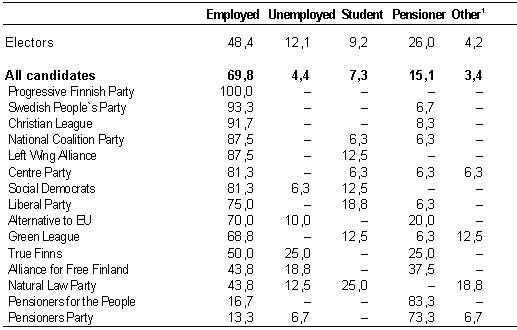21 October 1996
The unemployed and young dormant in the Euro-elections
The unemployed appear to have participated feebly in the elections of the European Parliament, as indicated by a survey by Statistics Finland. Compared to the previous general elections the voting turnout also fell in areas where the population structure is young, where there is little agriculture and in areas with a proportionately high degree of inhabitants with low income.
Statistics Finland analysed the changes in the support gained by the political parties by population groups according to profiles on the voting districts. The analysis is based on the data of 1 500 voting districts, not on the voting of individual voters.
The increase in the support of the Centre Party appears to originate from those Finnish-speaking regions where the voting turnout was low in these elections and where there was opposition to Finland's EU membership in the 1994 referendum. The Social Democrats lost votes in the areas where the voting turnout was poor, and where the share of agriculture and service industries is low.
Typical candidate of the European Parliamentary
Elections:
Employed, academically qualified, well-paid, aged 47 years, married
and male
The typical candidate of the European Parliamentary elections was an academically qualified man with a job that pays well, aged 47 years and married. The candidates had a clearly better level of income than their electors, the study by Statistics Finland on the social background of the candidates and voters indicates.
Over two thirds of the candidates were employed at the end of 1994. Every second candidate held a position in public administration, education, health care, in organisations or in the field of culture. Two out of three were academically well qualified.
Just under one half of the electors were employed at the end of 1994 while 12 per cent were academically well qualified.
The average income subject to state taxation of the candidates amounted to FIM 210 000 in 1994, being twice as high on average as those of the electors. Half of the candidates had wealth amounting to at least FIM 156 000 in the 1994 taxation and liabilities of at least FIM 56 000.
Candidates and electors of the European Parliamentary
elections
by main type of activity as at 31 Dec. 1994, %

1Employed: wage earner or entrepreneur.
2 Other: e.g. home-maker
The parties generally entered one Swedish-speaking candidate in their lists, 2-3 candidates living single, 1-2 students and one pensioner. 128 of the candidates were men and 79 were women. The average age of the candidates was approximately 47 years, being almost the same as that of the electors.
Even seats for major parties in the European Parliamentary elections
The Centre Party, the Social Democratic Party and the National Coalition Party each received four representatives in the European Parliament, the Left Wing Alliance received two representatives, and the Green League as well as the Swedish People´s Party both one representative.
Votes cast for the major parties
in the European Parliamentary elections 1996, %

Municipal elections: Social Democrats lost 2.6 percentage points
The municipal elections in Finland were held at the same time as the European Parliamentary elections. The votes cast for the major parties were the following (change on the previous municipal elections in brackets): Social Democrats 24.5% (-2.6), Centre Party 21.8% (+2.6), National Coalition Party 21.6% (+2.5), Left Wing Alliance 10.4% (-1.3), Green League 6.3% (-0.6) and Swedish People´s Party 5.5% (+0.5).
The voting activity in the municipal elections was 61.1 per cent, which is 1.1 percentage points higher than in the European Parliamentary elections and 9.8 percentage points smaller than in the municipal election of 1992.
Source: European Parliamentary Elections 1996.
Statistics Finland
Inquiries: Mr Risto Lättilä, tel. +358 9 1734 3252, or Ms Eeva
Heinonen,
tel. +358 9 1734 3268, or Ms Kaarina Jokinen, tel. +358 9 1734
3246
INTERNET: HTTP://WWW.STAT.FI
